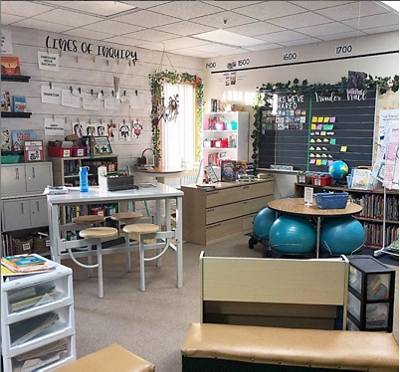
Upon graduation, young adults are released into a beautiful, vibrant world where they can grow and flourish in their individual ways. They can choose what to do and how they do it; they’re allowed to ask why and make their choices accordingly. Without understanding how to evaluate and make decisions, they may become stagnant. They may not realize consequences or, conversely, the positive impact of a well-considered decision.
Because learning is a life-long process, it doesn't make sense to completely ignore a child's agency. My students step into their fourth grade classroom at an age that is deeply formative but still so wildly imaginative. They're capable of experiencing so many emotions but they may not know why they feel that way. They don't realize that positivity and happiness can be the result of a choice; they don't even realize that their lifetime will be full of choices.
Introducing flexible seating was a way to give every student the power to think for themselves, even if that choice is small. It isn't about creating the illusion of choice-- it's real. We split up the school day to best accommodate different modes of learning. When we have lessons, we all move to a carpet at the front of the room, coming together to gather and learn. When it's time to work independently, they scatter about the room, deciding what will work best for them.
This is their flexible time. At the beginning of the year, I teach them how to sit in the various types of rockers, yoga balls, and desks, telling them that a yoga ball isn't for bouncing and a rocker isn't for play. When worktime comes around, they migrate to the seat that they think will work best for them, having explored the options and realized on their own that they know what they want.
"Kids are so transient--so mobile--in todays world."
As with everything new, my personal journey through implementing flexible seating has been just as much of a learning process. There were events that I learned from and, over time, I figured out how to make this project work for my classroom, my students, and my teaching style.
After my first year of teaching in a traditional classroom, I saw students squirming and fidgeting in their seats and began thinking "how do I let them move?" From there, it started with four yoga balls and continued to grow. The next year, I abandoned the desks completely and fully integrated flexible seating. As idealistic as this may have been, it didn't account for kids who work best with a simple chair and a desk.
"I had a student who walked in and said, 'oh my gosh, this feels like a house!' and that was the best compliment - I had this four wall cinderblock classroom- but it felt homey."
Adjusting my plans, I brought back a few traditional desks and chairs; they're just as important as the other options for the kids who prefer them. At the same time, I brought even more active pieces into the classroom. Using even more yoga balls, rocking chairs, cushions, wobbling stools, camping chairs, and more. The options expanded--kids were even allowed to sit at my desk!--and every child could explore and see what worked best for them. They saw what was the most fun or most productive and they learned what they didn't like.
Meanwhile, I saw a shift in students' behavior. The fidgety students were able to subtly meet their need to wiggle, the troublemakers were preoccupied, and the class as a whole benefitted from the freedom. During worktime it was easy to see who was paying attention, making it easy for me to concentrate on each student as an individual.
"I can see everybody, and I can see who's listening"
Every student is a unique individual with unique needs. Every student wants to feel comfortable and safe in their school-- they don't want to feel constrained or imprisoned, as if they're in a jail. Flexible seating doesn't just color the landscape of my classroom; it is a way to preserve the kids' individuality and expression without taking away from the importance of learning.
It still isn't about the illusion of choice-- it's about the power of choice and how it will be important for the rest of their lives. Starting small with the ability to choose a seat, we pave the way for more choices and more ways that these kids can define their place in the world. We're seeing more and more teachers move to flexible seating patterns. More than a trend, it has become a movement that kids and parents have embraced. Even if it's just one part of a happy and healthy classroom, it has made a positive impact for the teachers and students who have embraced its benefits.
The future is flexible. It has always been flexible. Students face more opportunities than ever and shifts in the modern classroom are just one way to encourage growth. Learning is a life-long process and there isn't one singular path that one may take. Stay flexible; stay active in the journeys ahead. The option to grow makes all the difference and sometimes it starts with a seat.

0 Comments